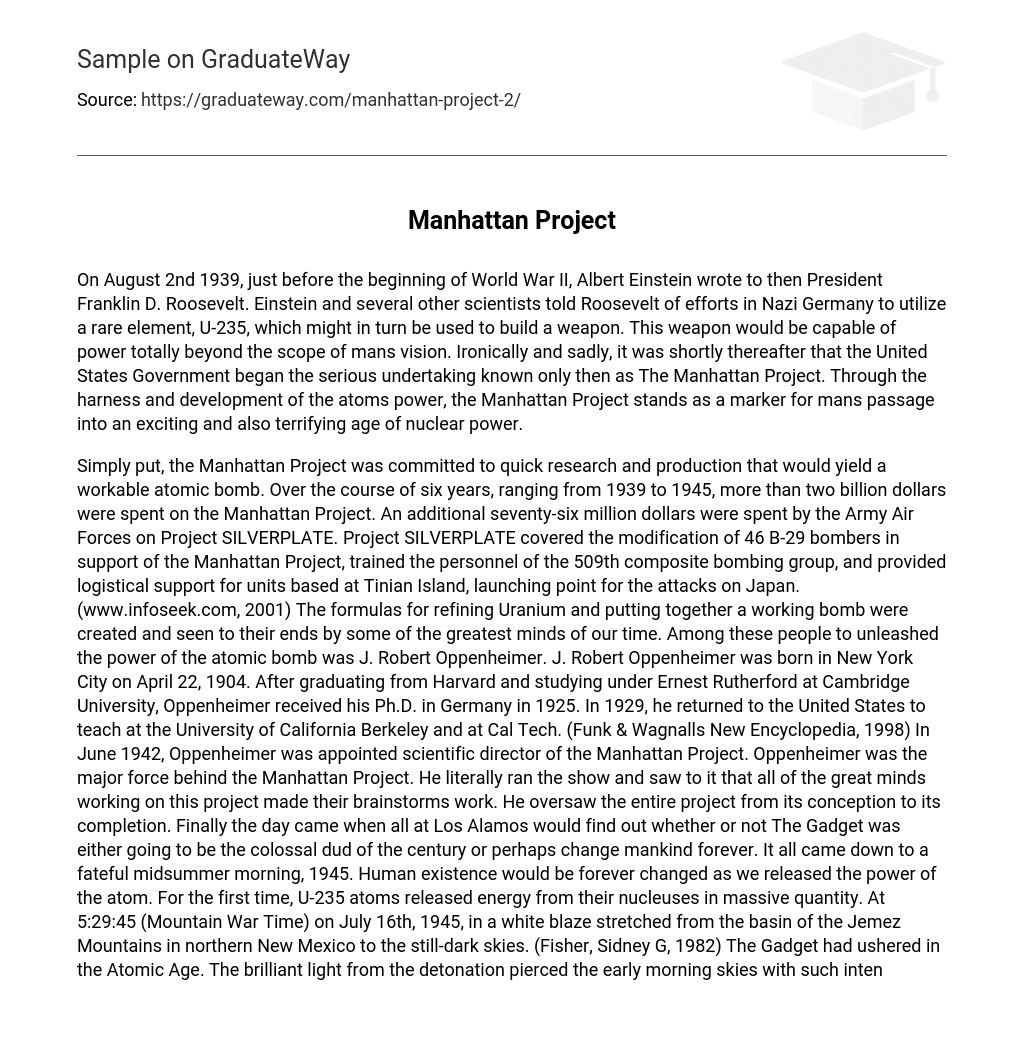In a letter dated August 2nd, 1939, Albert Einstein informed President Franklin D. Roosevelt about the Nazi Germany’s endeavor to utilize U-235, a scarce element, which had the potential to be weaponized. This communication took place shortly before the onset of World War II and involved Einstein and a group of scientists.
This weapon would have an unimaginable power, but shortly after this, the United States Government initiated a major endeavor known as The Manhattan Project. Its goal was to harness and develop atomic power, marking mankind’s entry into a thrilling yet terrifying era. Essentially, the project focused on rapidly researching and building a functional atomic bomb. The Manhattan Project spanned from 1939 to 1945 and incurred a cost of over two billion dollars.
The Army Air Forces allocated an additional $76 million for Project SILVERPLATE, which had the objective of altering 46 B-29 bombers for the Manhattan Project and providing training to personnel from the 509th composite bombing group. Furthermore, Project SILVERPLATE extended logistical support to units stationed at Tinian Island, where Japan attacks originated. The development and implementation of refining Uranium and constructing a functional atomic bomb were overseen by brilliant individuals. J. Robert Oppenheimer was among these crucial figures who played a pivotal role in harnessing the potential of the atomic bomb.
J. Robert Oppenheimer, born in New York City on April 22, 1904, graduated from Harvard and studied under Ernest Rutherford at Cambridge University. He obtained his Ph.D. in Germany in 1925 before returning to the United States to teach at the University of California Berkeley and Cal Tech (Funk & Wagnalls New Encyclopedia, 1998). In June 1942, Oppenheimer assumed the role of scientific director for the Manhattan Project.
Oppenheimer played a crucial role in the Manhattan Project, overseeing its entire development and ensuring successful execution of ideas from start to finish. In 1945, on a significant summer day, the Los Alamos community eagerly anticipated the result of The Gadget – a test that would determine whether it would be a colossal failure or a catalyst for transforming humanity. Ultimately, on that day, mankind discovered the power of the atom, permanently altering human existence.
U-235 atoms produced an unprecedented amount of energy from their nuclei for the first time. On July 16th, 1945, at 5:29:45 (Mountain War Time), a blinding white flash extended from the Jemez Mountains’ basin in northern New Mexico, illuminating the still-dark skies. (Fisher, Sidney G, 1982) This event marked the beginning of the Atomic Age, as the Gadget had made its appearance. The intense brightness of the explosion was so remarkable that residents from distant neighboring communities believed that the sun had risen twice that day.
After witnessing the explosion, it became evident that those responsible for it had strong reactions. J. Robert Oppenheimer, who had dedicated himself to the project and was delighted by its success, famously said, “I am become Death, the destroyer of worlds.” Ken Bainbridge, the test director, conveyed his belief to Oppenheimer that they had all now become “sons of bitches.” The power of this weapon was so devastatingly immense that using it against others seemed inhumane. Several participants who observed its outcome signed petitions pleading against unleashing this destructive force they had created. However, their pleas were disregarded. At that time, this project had consumed a significant amount of money, time, effort, man-hours and labor.
(Cochran, Thomas C, 1966) The question at that moment was not the timing of America’s use of the bomb in combat, but rather when it would occur. Unfortunately, the Jornada del Muerto of New Mexico was not the last place on Earth to witness an atomic explosion. As many are aware, atomic bombs have been employed only twice during warfare. Hiroshima stands as the first and most significant location where such a bomb was utilized. On August 6th, 1945, a Uranium bomb weighing over four and one-half tons known as “Little Boy” was dropped on Hiroshima. The Aioi Bridge served as the intended target for this bomb.
Ground Zero was situated 1,980 feet from the intended target. The bomb dropped by the Enola Gay missed its target by just 800 feet at 0815 hours. At precisely 0816 hours, an atomic explosion of 10 kilotons magnitude resulted in the loss of 66,000 lives and injuries to another 69,000 people. This disastrous incident led to total devastation within a one-mile radius and extensive blast damage within a two-mile radius.
In the vicinity, flammable materials were ignited about 2.5 miles away, causing fires to spread over a perimeter of just over three miles. On August 9th, 1945, Nagasaki suffered a similar fate to Hiroshima when it was struck by a Plutonium bomb called “Fat Man.” Despite missing its intended mark by more than 1.5 miles, “Fat Man” effectively destroyed nearly half of the city.
The population of Nagasaki experienced a sudden decrease from 422,000 to 383,000. The explosion caused the deaths of 39,000 individuals and injured over 25,000 people. This blast had a magnitude equivalent to 10 kilotons.
During the early days of The Atomic Age, there was a widespread belief that atomic bombs could be used in mining operations and even aid in constructing a new Panama Canal (Gray, Elizabeth Janet, 1978). The immense power released from these bombs fueled optimism about their potential applications such as propelling space ships, powering vehicles, and heating homes.
Contrary to expectations, atomic destruction did not diminish but rather expanded in military usage. Frequent atomic tests were conducted at locations such as the Bikini Atoll. These tests persisted until the implementation of the Nuclear Test Ban Treaty. It is disheartening that, despite 55 years of progress in information, technology, and development, nuclear power has primarily been employed for manufacturing weapons of mass destruction.
The introduction of mankind into the atomic age is undeniably terrifying.





